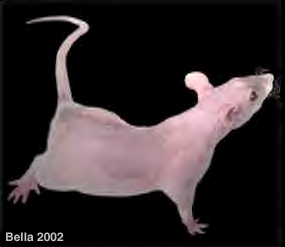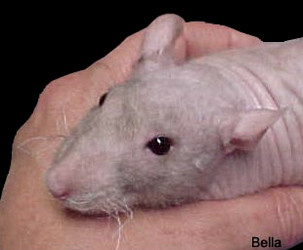Figure 2c: Woody’s megacolon
Case history and photos

|
Name: BN Woody
Type: tricolor ruby eyed double rex hairless
DOB: March 23, 2001
DOD: September 24, 2002
Condition: Late onset genetic megacolon
Megacolon inherited from: Father – tricolour, blazed, rex, dumbo, odd-eye
Bred by: Joanne “Bella” Hodges
Age at time of death: 19 months old
The First 8 weeks:
Woody appeared of normal weight and size for the first two weeks following delivery. Being a double rex , the hair was lost by the age of 4 weeks. It became obvious by this time, that he was not growing at the same rate as his siblings, and by 6 weeks of age, Woody’s failure to thrive made him seem as if he didn’t even appear to be from the same litter.
Although Woody had a half sister that had presented with megacolon, and was euthanized at 5 weeks, it had not yet become apparent at the time that Woody had any colon disease.
Clinical Signs and Early Treatments:
The first signs observed was early failure to thrive. By 2 months it was noted that he only defecated every few days. The feces were dry, cylindrical with blunt ends, and larger than normal. Occasionally after a hard movement there would be episodes of diarrhea and rectal bleeding, finally resulting in complete blockage .
By the age of 3 months it was confirmed that Woody indeed had late onset megacolon. As the condition worsened his abdomen became distended. The intestines impacted with stool, were actually visible through his skin. Prognosis at this time was poor, and his life expectancy thought to be short, even with medical intervention.
Discovering a recommended treatment read on the internet, Woody was put on a high fiber diet and given enemas daily with warm slightly soapy water to remove the blockages.
His veterinarian put him on propulsid (cisapride) and lactulose. The blockages worsened and the constant enemas were causing him a lot of stress.
It was noted that the feces were becoming increasingly fibrous and dry making them harder for him to pass. He was then taken off the high fiber diet and kept on the medications. Although there was significant improvement seen with his condition, bloating continued to be factor causing discomfort, and consideration was given at this time to euthanize.
Stabilization achieved
It was decided to continue treatment. Woody was very patient as modification was made to his diet , and enemas continued to be given. Finally, after a series of trial and error, Woody’s condition began to stabilize to a greater degree with the new treatment regimen.
At this time treatment regimen consists of a careful diet, (“Woody’s Megacolon Diet“) colonic massage, and enemas twice a week (or as needed). His enemas are warm soapy water and occasionally mineral oil. Twice a week he also gets mineral oil in his rice cereal. He is also given lactulose as needed.
Since implementing this treatment plan Woody has only had 2 critical blockages that with care were resolved.
Woody manages to survive with grace, and is a loving and personable boy. He is required to live alone due to his special diet. He is not at this time on cisapride due to its unavailability on the market, and the vet’s supply being exhausted. It has however recently been made available by internet order. Woody has been off cisapride for several months. If his current treatment fails him or his condition worsens cisapride will again be implemented.
*AS A NOTE*
Do not give laxatives if there is a serious blockage.
Do not flush the colon with too much fluid during an enema.
Conclusion of Case history
On the morning of September 24th, 2002 Woody was behaving normally. He was alert and taking snacks with his usual enthusiasm. It was noticed in the afternoon that Woody seemed lethargic and he was not interested in food.
Upon physical examination there didn’t seem to be any major blockage or obvious pain. He simply looked as if he was not feeling well. He passed away that evening, apparently while sleeping. Woody was 19 months old at his time of death.
Woody was necropsied By Dr Richard Mckiniss, DVM; at the South Seminole Animal hospital.
It was noted at necropsy that there were no blockages or perforations. His colon was significantly enlarged and showed signs of infection. It was also noted during necropsy that the liver exhibited abnormalities.
The cause of death was sepsis, hence the term “toxic megacolon.” The inability of his colon to pass waste finally created a situation where the bacteria entered his bloodstream through the colonic vessels causing either respiratory or cardiac failure. From the appearance of Woody at his time of death our guess is that it was most likely cardiac failure. Thankfully, it did not seem as if he suffered.
 Photo 2: At 19 months. Goodbye Woody, sweet prince. |
Link provided here to necropsy photos. Warning! These photos are graphic in nature.
Case history and photo courtesy of Bellaratta’s Nest Rattery


